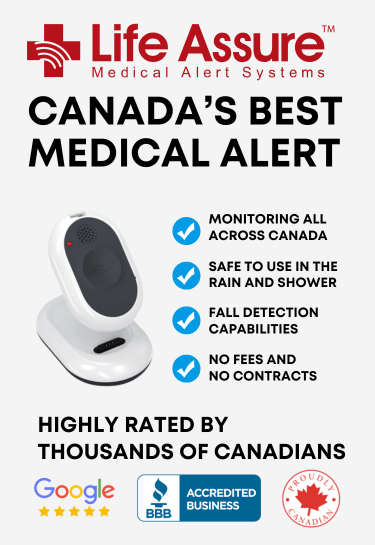Senior Transportation Options In Canada: Easy And Affordable Ways To Get Around
Reliable senior transportation helps seniors maintain independence as they age. Knowing the available transportation options is crucial for Canadian seniors to stay active and connected. Numerous transportation methods are tailored to seniors in Canada, from public transit and specialized services to ride-sharing apps. Explore these options so seniors can overcome mobility challenges and lead independent lives.
Life Assure Product Quiz
Find The Perfect Medical Alert Device
Take our 30 second quiz and discover which Life Assure medical alert device is the right fit for you or a loved one.
Life Assure Product Quiz
Find The Perfect Medical Alert Device
Take our 30 second quiz and discover which Life Assure medical alert device is the right fit for you or a loved one.
Accessible Transportation For Seniors
As people age, mobility challenges can make driving difficult or unsafe, leading to potential isolation and limited access to essential services. This isolation can negatively affect mental and physical health.
Transportation is a means of travel and a connection to the community. It allows seniors to attend medical appointments, visit loved ones, and participate in social and recreational activities.
The absence of accessible transportation can also increase reliance on family or caregivers, which isn't always practical. Learning and utilizing available transportation options allows seniors to maintain their independence and overcome these barriers.
Public Transportation Options For Seniors
Public transportation is a budget-friendly way for many Canadian seniors to get around cities. Major urban centers like Toronto, Vancouver, and Montreal boast extensive transit networks, including buses, subways, and light rail, all designed with seniors in mind. Low-floor buses, priority seating, and clear audiovisual announcements cater to those with mobility or sensory needs.
One advantage for seniors is the availability of discounted fares. Many transit systems offer reduced rates, making frequent travel more affordable. For instance, the Toronto Transit Commission (TTC) provides senior discounts on monthly passes and single fares, while Vancouver's TransLink offers a discounted Compass Card for seniors.
Accessibility remains a priority for transit agencies, with ongoing improvements like elevators and escalators at major stations. Staff are trained to assist seniors and individuals with disabilities. Some cities even offer travel training programs to help seniors navigate the system confidently.
COVID-19 Safety Measures In Senior Transportation Services
In response to the COVID-19 pandemic, senior transportation services across Canada have implemented enhanced safety measures to protect passengers. These measures help minimize risks while ensuring that seniors can still access essential transportation services.
Many public transit systems have increased cleaning and sanitation protocols, focusing on high-touch areas like handrails, seats, and fare machines. Masks and physical distancing were enforced at the height of the pandemic, and many agencies continue to encourage their use, especially during peak hours.
Specialized senior transportation services, including volunteer driver programs and non-emergency medical transportation, have also adapted to ensure safety. Vehicles are frequently sanitized, and drivers may wear masks or gloves. Some services limit passenger numbers to allow for better distancing.
Ride-sharing and taxi companies have incorporated similar precautions, such as contactless payment options, mandatory masks for drivers and passengers during outbreaks, and regular vehicle disinfection.
These ongoing efforts ensure that seniors can travel safely while reducing their risk of exposure to illnesses.
Specialized Senior Transportation Services
Beyond public transit, Canadian seniors can access specialized transportation services that cater to their unique needs. These services provide a more personalized travel experience, especially for those who find standard public transit challenging.
Community shuttles and door-to-door services are popular options. Community shuttles usually operate within specific areas, making regular stops at key locations like shopping centers and healthcare facilities. Door-to-door services offer even more convenience by picking up seniors directly from their homes and dropping them off at their destinations.
Eligibility for these services can vary. Seniors typically need to register with the service provider and may need to show proof of age or mobility challenges. While some services charge a small fee, many are subsidized by local governments or non-profits to keep them affordable.
Ride-Sharing And Taxi Services
Ride-sharing and taxi services offer Canadian seniors a flexible and convenient way of traveling. Apps like Uber and Lyft have gained popularity, providing on-demand rides that seniors can access via smartphone. These services are widely available in urban areas and include features tailored for seniors, such as sharing trip details with family for added peace of mind. Some services even offer vehicles equipped for mobility aids like walkers or wheelchairs.
Traditional taxi services remain a reliable option for seniors who prefer not to use smartphone apps. Many taxi companies offer discounts or loyalty programs to make rides more affordable. Seniors can hail taxis on the street, book them by phone, or reserve them online, ensuring accessibility for seniors regardless of their comfort with technology.
In smaller communities where ride-sharing might not be as common, local taxi services provide essential transportation to nearby towns or cities. Seniors can enjoy the benefits of private transportation without the responsibilities of owning a vehicle.
Volunteer Driver Programs
Volunteer driver programs provide a vital lifeline for Canadian seniors, offering senior transportation with a personal touch. Non-profits or community groups run these programs. They rely on volunteers who use their cars to help seniors get to medical appointments, grocery stores, and social events.
What sets these programs apart is the relationship-building aspect. Volunteer drivers often form bonds with the seniors they assist, offering rides and companionship.
To use these services, seniors typically need to sign up with the organization running the program. The registration usually involves sharing basic details about their transportation needs and mobility issues. Many programs are free or charge a small fee, making them accessible for seniors on a budget.
Non-Emergency Medical Transportation
For Canadian seniors, getting to medical appointments without hassle is crucial for maintaining health. Non-Emergency Medical Transportation (NEMT) services help seniors reach their healthcare providers for routine check-ups, specialist visits, or therapy sessions.
Various organizations and government programs across Canada provide NEMT services. Some provinces have specific initiatives, often run by local health authorities or community groups, to subsidize transportation costs for medical visits. In Ontario, for instance, the NEMT program supports eligible seniors with travel to healthcare facilities.
Adaptive Transportation Solutions
Adaptive transportation options are crucial for safe and comfortable travel for seniors facing mobility challenges. Seniors can modify vehicles with features like wheelchair lifts, hand controls, and swivel seats. Programs such as Ontario's Home and Vehicle Modification Program offer financial assistance for these adaptations, making personal vehicles more accessible.
Rental services like Enterprise and Avis provide vehicles with adaptive features for those who don't own a car or prefer not to drive. These rentals are available in many Canadian cities and offer flexibility for short-term needs or specific trips.
Tips For Choosing The Right Transportation Option
Selecting the best transportation option involves considering several factors:
- ● Cost: Look for affordable options, including senior discounts. Public transit and volunteer programs often provide cost-effective solutions.
- ● Accessibility: Ensure the method accommodates mobility needs, such as wheelchair access.
- ● Reliability: Check the punctuality and coverage of services, as dependable transportation is crucial for appointments and social activities.
- ● Convenience: Consider ease of scheduling and use. Ride-sharing apps offer flexibility, while door-to-door services provide direct pickups.
- ● Safety: Evaluate the safety features, including driver training and vehicle condition.
Conclusion
Senior transportation is key to enhancing the lives of older Canadian individuals, offering the freedom to stay active and connected. Seniors can maintain their independence and continue participating in their communities by exploring the diverse options available, from public transit to adaptive solutions. Encouraging seniors to utilize these resources supports their mobility and enriches their social and mental well-being, ensuring they remain an integral part of their communities.











 Get Help With The Push Of A Button
Get Help With The Push Of A Button















